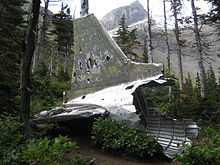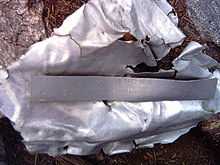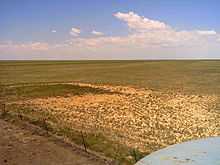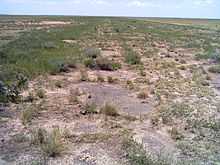Aviation archaeology
Aviation archaeology is a recognized sub-discipline within archaeology and underwater archaeology as a whole.[1] It is an activity practiced by both enthusiasts and academics in pursuit of finding, documenting, recovering, and preserving sites important in aviation history. For the most part, these sites are aircraft wrecks and crash sites, but also include structures and facilities related to aviation. It is also known in some circles and depending on the perspective of those involved as aircraft archaeology or aerospace archaeology and has also been described variously as crash hunting, underwater aircraft recovery, wreck chasing, or wreckology .
History of Aviation Archaeology and Current Issues

The activity dates to post-World War II Europe when, after the conflict, numerous aircraft wrecks studded the countryside. Many times, memorials to those involved in the crashes were put together by individuals, families, landholders, or communities. The United Kingdom, whose land was littered with enemy aircraft, introduced a scrap metal initiative for the public which encouraged its disposal. Members of the public who found aircraft sites, especially farmers who could dig them up, could profit off the sale of the scrap metal.
Beginning in the 1970s, especially in the United States and the United Kingdom, looting of aviation wreck sites began to disturb the general public. As the activity grew, laws and regulations were created in some areas to counter problems created, such as trespassing and the disturbance of "war graves".

Crash sites vary in size and content; some may have fuselages, engines, and thousands of parts and debris. Other sites, like in civilian/commercial crashes, the Federal Aviation Administration and the National Transportation Safety Board (NTSB) will have almost all of the aircraft and debris removed; which makes aviation archaeology more challenging. Remains of military aircraft crash sites may also be removed by various aircraft restoration groups, particularly if the aircraft was found largely intact. In general, most recent-day (since the 1980s) aircraft crashes are removed entirely, due to environmental regulations, leaving very little to indicate the existence of a wreck.
For example, military crashes in Arizona originate from numerous air bases, past and present. Because of the warm and sunny weather, much of the U.S. Army Air Forces flight training was located in the state, both during and after WWII. Numerous air bases dotted the states - creating conditions for numerous training accidents.[2] Old abandoned US Army Air Corp auxiliary fields and those converted to city municipal airports provide archaeological sites to be researched and investigated.[3]

Keeping a record of a crash site, such as photographs, maps, journals, logs, and all terrain and weather recordings are essential, i.e. the Glenwood Springs, Colorado, B-17 crash site[4] or the Tells Peak, CA, B-17 crash site.[5]

The internet is an ideal media for sharing, recording, educating, and promoting aviation archaeology as a hobby, as well as research projects for local and state aviation historical groups. For identifying aircraft type and manufacturer by part numbers[6] and manufacturing inspection stamps[7] can be analysed. From detailed GPS data & maps, to researching accident reports information, numerous resources help create a complete picture of the historic event. Accident reports, such as the official US Air Force Accident Report[8] Form 14 becomes the foundation of archaeology research. From there, newspaper articles, county clerk records, sheriff & coroner reports, and library records all aid an aviation archaeologist in their research.
Protection Laws and Regulations
United States
Legal protection of aircraft wreck sites is highly variable. In terms of protection by aircraft ownership, the U.S. Navy retains indefinite ownership of all Naval aircraft, including terrestrial or submerged wreck sites.[9] The U.S. Air Force has no policies regarding disturbance of vintage aircraft wreck sites, unless human remains or weaponry remain unrecovered at the site. For vintage aircraft, including vintage military aircraft, that are usually considered abandoned when wrecked, the wreck site and all associated contents are subject to the protection laws of the land upon which it rests. The language of cultural heritage protection laws are not aviation specific, so all protection laws pertaining to aviation sites are based on interpretation. Most federal and state laws are, however, explicit in describing cultural resources as either ‘objects, sites, or otherwise, of historic value’[10][11] or ‘military or social history’[12] and deem the time limit as over fifty years old. If an aircraft wreck is over fifty years old, which includes all aviation wreck sites from WWII, and crashed on what is currently federal lands, the sites are automatically protected under National Park Service Law 36CFR2.1[13] against disturbance of any kind without a permit. Sites on federal land are further protected under the National Historic Preservation Act of 1966 throughout a determination process. The act stipulates that all historic sites must undergo a Section 106 review to determine eligibility for the National Register of Historical Places prior to being disturbed. Federal lands include, among others, National Parks, National Forests, National Marine Sanctuaries, and land owned by the United States Army Corps of Engineers. Aviation sites, for example a vintage hangar on an airport or a wreck site on the path of a proposed highway, are also immediately subject to Section 106 review if they are to be disturbed by a project that either requires a federal permit or uses federal funds. In most cases, the State Historic Preservation Officer will determine whether or not an aviation site is eligible for the register.
The National Register deems aviation wreck sites as “any aircraft that has been crashed, ditched, damaged, stranded, or abandoned”.[14] It designates the protection terms for aviation history sites as well, including abandoned airfields or facilities sites, testing or experimental sites, land or water air terminals, or airway beacons and navigational aids.
State lands protection laws vary widely across the nation but the language describing a historical resource is the same as federal laws. Therefore, aviation properties and aircraft wrecks on State lands can be protected under various environmental, public resource, and historical property laws as outlined per state for the protection of archaeological and historic resources. Any archaeological survey, excavation, or activity that disturbs wither wreck or aviation property remains can, in some cases, be permitted on federal and state lands under a permitting process through the regulating entity. If an aircraft wreck, or the remains of any aviation property, is located on private land it is not automatically protected by any federal, state, or local law and any survey or excavation work must be permitted by the land owner.
Under the 'Sunken Military Craft Act’ (SMCA) of 2004, it is illegal to disturb, remove, or injure the wreck sites or associated contents of U.S. Naval or any submerged military aircraft.[15] The act identifies military craft as including any sunken military aircraft or military spacecraft that was owned or operated by a government when it sank, and includes the associated contents. Because of the U.S. Navy’s retaining of ownership of all military craft, the act applies to any U.S. Navy aircraft, even if in international or other country’s territorial waters. The act also applies to any foreign military craft in U.S. territorial waters. Persons wishing to conduct archaeological or research exploration of any submerged military aircraft can apply to the Naval History and Heritage Command’s Underwater Archaeology Branch for a permit. The SMCA includes penalties associated with any unauthorized disturbances of sunken military craft as a fine and a liability for the reasonable costs incurred in recovery of archaeological or cultural information, storage, restoration, care, maintenance, and conservation.
As a part of federal air regulations, NTSB Part 830, protects any aircraft whose accident cause is under investigation.[16][17] NTSB officials will routinely seize portions of wrecked aircraft for further analysis. Most of the time, after their study is complete, the sequestered debris is returned to the owners' representation - most often the aircraft's insurance company. However, examples like the reconstructed wreckage of TWA Flight 800 are held in perpetuity by the NTSB to education the public and future investigators on the NTSB's role in transportation safety.
United Kingdom
The laws in the UK cover the remains of all aircraft which have crashed during military service (land or sea) are protected by the Protection of Military Remains Act 1986. This Act defines an offence of tampering with, damage to, moving, or unearthing the aircraft remains. Exceptions apply to those holding licences, which can be issued by the Secretary of State, authorising specific procedures to be performed.
For the wreck-chasing hobbyist there is a self-regulating body, the British Aviation Archaeological Council (BAAC),[18] which defines ethical standards of behaviour, coordinates activities and provides a forum for discussion for its member groups. Not all active groups in the UK are members of this organisation.
Types of Aviation Archaeology Sites
Terrestrial Sites
Aviation history sites on land that can be subject to archaeological survey or excavation can include airports (which can contain hangars, terminal, other facilities, etc.), crash sites, monuments, or even properties associated with important persons or events in aviation history. Some examples of potential and current archaeological sites:
Aircraft Crash Sites
The Loon Lake B-23 Dragon crash site in Payette National Forest, Idaho is a remarkably intact example of an aircraft wreck. The crew survived and was rescued, and some avionics removed from the site, and it currently is the subject of a teaching aviation archaeology field school in various years.
Abandoned airfields


Abandoned airfields can yield much information of historic information about aviation and related industries. From civilian airfields to military airfields, aviation archaeologists can find, uncover, and recover a variety of artifacts, just to name a few: aircraft parts with serial numbers, equipment parts, asphalt or runway material, variety of contamination, structures and foundations, businesses and economics, to community and cultural changes. With the closure of a military airbase, the street system and runways become local expansion of city streets and business; one example is the community conversion of Lowry Air Force Base to a local residential, commercial, and educational environment. Other bases, like the Arlington Auxiliary Army Airfield reverted to farming and ranching.
In 1990, 1994, and 1998, archaeologists investigated, using airborne remote sensing studies and limited excavation, a vintage hangar of the Huffman Prairie Flying Field Site at Wright-Patterson Air Force Base, Ohio. The investigations were “designed to provide information needed for site management by Wright-Patterson Air Force Base and the Dayton Aviation Heritage National Historical Park of the National Park Service. The geophysical and remote sensing investigations revealed magnetic, electromagnetic, and ground penetrating radar anomalies and infrared thermal images associated with the hangar structure. The archaeological excavations located an in situ wood post, posthole features, and artifacts which represent archaeological remains of the actual hangar”.[20] Huffman Prairie Flying Field is listed on the National Register of Historic Properties.
Another example is Hamilton Army Airfield in Novato, California. It was in use from 1929 until 1976. It was eventually turned over to the city of Novato for development of housing. The runway is also part of tidal wetland restoration effort currently underway by the U.S. Army Corps of Engineers, California Coastal Conservancy, and the San Francisco Bay Conservation and Development Commission.
Abandoned missile silos and sites
California has missile launch sites abandoned by the US Army.[21] Archaeological research includes these sites throughout the United States. Exploring and hiking around abandoned silos and sites may constitute trespassing as well as being dangerous.[22] Permission from current land owners or caretakers is imperative. Research and formal site investigations adds to the historical record of the Cold War. One such site is the Minuteman Missile National Historic Site.[23]
In the Golden Gate National Recreation Area is a decommissioned Cold War era Nike Missile base, Nike Missile Site SF-88. In 1954, it was armed with Nike Ajax missiles. In 1958, it was converted to Nike Hercules nuclear missiles. After it was shut down in 1974, it was turned over to the National Park Service. It is now open for tours on the first Saturday of every month from 12:30-3:30.
Underwater crash sites
A B-29 "Superfortress" Serial No. 45-21847 ditched in Lake Mead in 1949. This particular aircraft is listed in the National Register under Criterion C as an example of a significant type of aircraft construction and under Criterion D for it potential to yield important information.
The remains of the USS Macon Airship and its associated F9C Sparrowhawks are located at around 1500 feet in the Monterey Bay National Marine Sanctuary. The National Oceanic and Atmospheric Administration (NOAA) has run survey expeditions to the site, creating photomosaics to track deterioration. The wreck site is listed on the National Register.
Underwater surveying and recovery
Underwater search and recovery is a complex aspect of aviation archaeology. Dive and recovery team have to do extensive research and planning before any recovery is performed. The aircraft site may be left as a memorial and not recovered. Once an aircraft has been located, an underwater survey is conducted before recovery operations begin. Many tasks are established and the research is a long process that requires the detailed review numerous and various sources of information. The complexities include a great deal of preparation, extensive training, precise planning, and very technical equipment and coordination. Conservation has often proved very difficult[24]
Australia
The Australian focus has been on underwater aviation archaeology,[25] partly as a result of the interest of the relatively large number of maritime archaeologists and shipwreck conservators in the field. This has resulted in numerous studies and reports, including some cross-fertilization or ideas, theory and techniques with practitioners in other parts of the world, with a strong emphasis on the involvement of conservators.[26] Underwater aviation archaeology commenced in Australia at the wrecks of the Dornier, Catalina, and Sunderland Flying Boats destroyed by Japanese fighters at Broome in WWII. These lie, both in the intertidal zone, and in deeper water.[27] The study continued in Darwin in the Northern Territory with research and fieldwork at its series of submerged PBY Catalina wrecks,[28] Subsequently the study has spread to other regions in Australia, partly as a result of the Interest of Flinders University and its postgraduate student body.[29] While military aircraft remain the property of their respective governments unless delegated to a third party, submerged aircraft wrecks (such as the wrecks at Broome in Western Australia), have proven to be quite difficult to protect from unauthorized recoveries and looting. Those in Broome are now protected under the provisions of the 1990 Heritage of Western Australia Act.[30]
As a profession
In America, aviation archaeologists, crosstrained in other areas of study, are found in the employ of Joint POW/MIA Accounting Command (JPAC), traveling to former war zones throughout the world, to search for the remains of American servicemen and women that have been lost. Many of these losses involve aircraft mishaps in remote and difficult to reach areas. A group of volunteers, under the banner of "The BentProp Project", have pursued American military wreck sites and remains without disturbing them; their findings are forwarded to JPAC. In Australia and in some other parts of the world, where there are human remains involved, a tendency has been for the armed forces to secure the services of forensic anthropologists and crash investigators.
Professional aviation archaeologists may also be involved in the recovery of near-complete examples of wrecked or abandoned aircraft for profit. The clients of these professionals range from private individuals and aviation museums, to government agencies. Often these aircraft are in remote areas, which aids wreckage preservation.[31] Examples include Glacier Girl, a Lockheed P-38 Lightning that was successfully recovered from below the Greenland ice cap, and restored to airworthy condition, and Kee Bird, a Boeing B-29 Superfortress also abandoned on the Greenland ice cap, but severely damaged by recovery efforts.
In June 2009, the Wreckchasing/Aviation Archaeology Symposium, on the topic of wreckchasing and aviation archaeology was held in northern California at Moffett Field near Mountain View.[32]
North America conference
On April 17 & 18, 2010, a group of aviation archaeology professionals, avocational and interested persons met in Broomfield, Colorado at the Rocky Mountain Metropolitan Airport for a two-day summit. The attendees came from Arizona, California, Canada, Colorado, Illinois, New Mexico, and Oklahoma representing the interests of wreck chasers, aircraft recovery teams, and avocational archaeologists. The North American Aviation Archaeology Summit was conducted and sponsored by the North American Institute of Aviation Archaeology[33] and Colorado Aviation Historical Society's Aviation Archaeology Program's Staff. Some of the attendees had also attended the 2009 Symposium at Moffett Field. The group discussed all aspects of aviation archaeology, wreck chasing, recovery, modern archaeology techniques, ethics, education, training, hobby enthusiasts, and professional interests. Breakout sessions, consensus, and voting occurred to determine the Summit outcome. The Summit created an organization initially representing the United States and Canada, now to be called: Aviation Archaeology and Heritage Association, and with full agreement to expand and include all nations interested in aviation archaeology and wreck chasing.[33][34]
See also
- Accidents and incidents in aviation
- Air safety
- Aerial archaeology
- List of aviation historical societies
- Crash cover
- Industrial archaeology
- Protection of Military Remains Act 1986
- Wreck diving
References
- ↑ McCarthy, M., 2004. Historic aircraft wrecks as archaeological sites. Bulletin of the Australasian Institute for Maritime Archaeology, 28: 81-90.
- ↑ Arizona Crash History
- ↑ Eastern Colorado Abandoned & Little-Known Airfields
- ↑ Glenwood Springs, CO, B-17 Crash Site
- ↑ Tells Peak B-17C Crash Site - Check-Six.com
- ↑ Part Prefix Numbers by Aircraft Type and Manufacturer List
- ↑ Unique Manufacturer Inspection Stamp Chart
- ↑ Sterling City, TX, B-36 Accident Report
- ↑ Historic Preservation Policy Regarding US Navy Sunken Military Craft
- ↑ National Historic Preservation Act 1966 Public Law 102-575 16 U.S.C. 470w
- ↑ National Historic Landmarks Program 36CFR65 et seq.
- ↑ California public resources code Section 5020-5029.5
- ↑ National Park Service Law 36CFR2.1
- ↑ Guidelines for Nominating Historical Aircraft Properties
- ↑ History.Navy.mil: The Sunken Military Craft Act (US)
- ↑ NTSB Part 830: U.S. Accident Preservation and Reporting Regulations (US)
- ↑ US Federal Registry: 49 CFR Part 830
- ↑ AviationArchaeology.org.uk Official Site
- ↑ Arlington Auxiliary Army Airfield Aerial View, see image no. 11
- ↑ "Archaeological, Geophysical, and Remote Sensing Investigations of the 1910 Wright Brothers' Hangar, Wright-Patterson Air Force Base, Ohio"
- ↑ US Army Nike Missile Sites
- ↑ History of Missile Silos
- ↑ National Park Service: Minuteman Site
- ↑ Canadian Harvard Aircraft Association Dive Recovery Team
- ↑ Western Australian Museum Broken Wings
- ↑ http://202.14.152.30/collections/maritime/march/fallenangels/fallenangels.html
- ↑ http://202.14.152.30/collections/maritime/march/treasures/broome/broome.html
- ↑ Jung, Silvano (2001). Wings Beneath the Sea: the aviation archaeology of Catalina Flying Boats in Darwin Harbour, Northern Territory. Unpublished Master of Arts thesis, Northern Territory University (now Charles Darwin University), Darwin, Northern Territory, Australia.
- ↑ e.g. Ford, J., 2006. WW Aviation Archaeology in Victoria Australia. Department of Maritime Archaeology. Flinders University. Adelaide.
- ↑ McCarthy, M., Green, J., Jung, S. and Souter, C., 2002. The Broome Flying Boats: Papers relating to the nomination of a suite of flying boat wrecks at Broome to the Register of Heritage Places under the Heritage Of Western Australia Act 1990. Report – Department of Maritime Archaeology Western Australian Maritime Museum, No. 170.
- ↑ Hoffman, Carl (2001). Hunting Warbirds - The Obsessive Quest for the Lost Aircraft of World War II. Ballantine Books. p. 245. ISBN 0-345-43617-2.
- ↑ Wreckchasing Message Board, Wreckchasing Symposium Update
- ↑ 33.0 33.1 North American Institute of Aviation Archaeology
- ↑ Colorado Aviation Historical Society: New Aviation Archaeology and Heritage Association for 2010
- All references re-accessed 26 February 2012
Further reading
- Freeze, Christopher (2005). The Wreck Chaser's Bible. Check-Six. p. 2 vols. ISBN 0-9765562-1-9.
- Gero, David (1999). Military Aviation Disasters-Significant Losses Since 1908. Patrick Stephens Limited, Haynes Publishing, UK. ISBN 1-85260-574-X.
- Jung, Silvano (2001). Wings Beneath the Sea: the aviation archaeology of Catalina Flying Boats in Darwin Harbour, Northern Territory. Unpublished Master of Arts thesis, Northern Territory University (now Charles Darwin University), Darwin, Northern Territory, Australia.
- McNab, Chris (2005). The World's Worst Military Disasters: Chronicling the Greatest Battlefield Catastrophes of All Time. New York: Barnes & Noble Books. ISBN 0-7607-7090-5.
- Merlin, Peter W. & Moore, Tony (2008). X-Plane Crashes: Exploring Experimental, Rocket Plane, and Spycraft Incidents, Accidents and Crash Sites; Specialty Press, North Branch, Minnesota. ISBN 1-58007-121-X
- Mireles, Anthony J. (2005). Fatal Army Air Forces Aviation Accidents in the United States, 1941-1945. McFarland & Co. Inc., Jefferson, NC. ISBN 0-7864-2106-1.
- Veronico, Nicholas A. (2013). Hidden Warbirds: The Epic Stories of Finding, Recovering, and Rebuilding WWII's Lost Aircraft. Zenith Press, Minneapolis, Mn. ISBN 978-0760344095.
- Veronico, Nicholas A., Ed Davies, et al. Wreckchasing: A Guide to Finding Aircraft Crash Sites; Pacific Aero Press, Castro Valley, Calif., 1993. ISBN 0-9636332-0-1
- Veronico, Nicholas A., Ed Davies, Michael B. McComb, Donald B. McComb. Wreckchasing 2: Commercial Aircraft Crashes and Crash Sites; World Transport Press, Miami, Fla. 1996. ISBN 0-9626730-3-X
- Pritzker Military Library Webcast Panel from December 4, 2012, on the ongoing efforts to recover and preserve aircraft lost in Lake Michigan during carrier qualifications in World War II
External links
- International sites
- TIGHAR.org - The International Group for Historic Aircraft Recovery
- Waymarking.com - coordinates for selected crash sites
- Australia
- Canada
- chaa-recovery.ca Canadian Underwater Recovery Team
- harvards.com Canadian Harvard Aircraft Association
- Germany
- UK sites
- British Aviation Archaeological Council - official site
- Thameside Aviation Museum - aviation archaeology
- Peak District plane wrecks
- US sites
- National Park Service's National Register Bulletin: Guidelines for evaluating and documenting historic aviation properties
- AircraftArchaeology.com - aircraft wrecks in Arizona and the Southwest
- Check-Six.com - aviation archaeology, before & after photos
- US Army Nike site information
- Wreckchasing.com - The on-line community for aircraft crash and crash site information.
- The X-Hunters.com - aerospace archaeology and the search for historic flight test aircraft
| ||||||||||||||||||||||||||||||
| ||||||||||||||||||||||